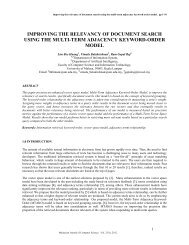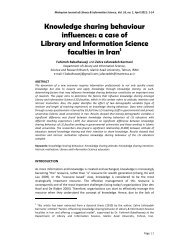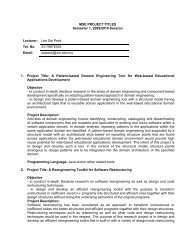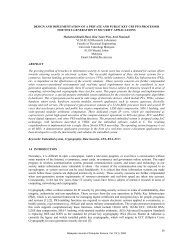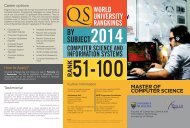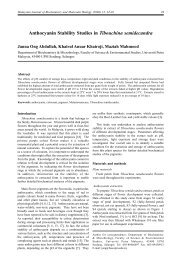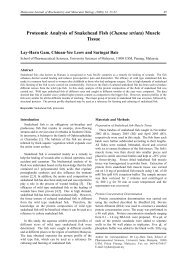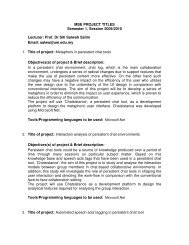You also want an ePaper? Increase the reach of your titles
YUMPU automatically turns print PDFs into web optimized ePapers that Google loves.
Tiew, W.S.distinguishing features of this particular type of citation. For this purpose, sheanalysed six journals, representing the core journals in plant physiology andneurobiology. The results indicated that self-citations was more recent and citedmore frequently in the text of the citing articles than citations of other authors.There was no indication of any relationship between self-citation and the numberof co-authors and to the size of the bibliography of the citing articles or to theirauthors’ productivity.Kundu (1981) carried out a study on self-citation using citation data obtained fromAnnals of Library Science (afterwards Annals of Library Science andDocumentation) during 1954-1975. He found that out of the 1545 citations, only231 citations (14.9%) were self-citations. He also noted that the top self-citingauthor is none other than the outstanding mahaguru of Indian library andinformation science, S. R. Ranganathan with a count of 174 self-citations.Muskhelishvili, Oganyan and Shreider (1987) undertook to explore self-citationanalysis as a method of research into the shaping of an author’s scientific andphilosophical concepts. They argued that self-citation analysis could reveal thereal order of the author’s thoughts and concepts backed by factual text leading to aparticular scientific discovery. They added that the author’s research findings playa part in the popularisation process together with the author’s participation in theappraisal of his own work.In 1989, Snyder and Bonzi, examined the motivation of authors in citingthemselves and others in their research papers. A total of 13 researchers weresupplied with copies of their research papers where they cited themselves andothers. At the same time, a list of reasons for citing was also given and theresearchers were asked to indicate the appropriate reasons for their citingbehaviour. They found that there were relatively few differences in motivatingfactors for citing themselves and others. Any difference noted was due tointellectual grounds and not self-aggrandisement. Zmaic, Maricic and Simeon(1989) on the other hand, carried out a study to distinguish between hidden selfcitationsand self-citations by primary authors of citing document.Bonzi and Snyder (1990) investigated patterns of self-citation in relation to the useof citations by others. The referencing patterns of authors of four disciplines, twoeach from the physical science and social science were collected and analysed todetermine the number, age of references and pattern of self-citation. They alsostudied the proportion of self-citations to all references and the exposure to selfcitationwithin text compared to other authors.Bonzi and Snyder (1991) again investigated the motivating factors in self-citationof 51 self-citing authors in several natural science disciplines. The results of thesurvey on reasons for both self-citation and citation of others indicated that there96



